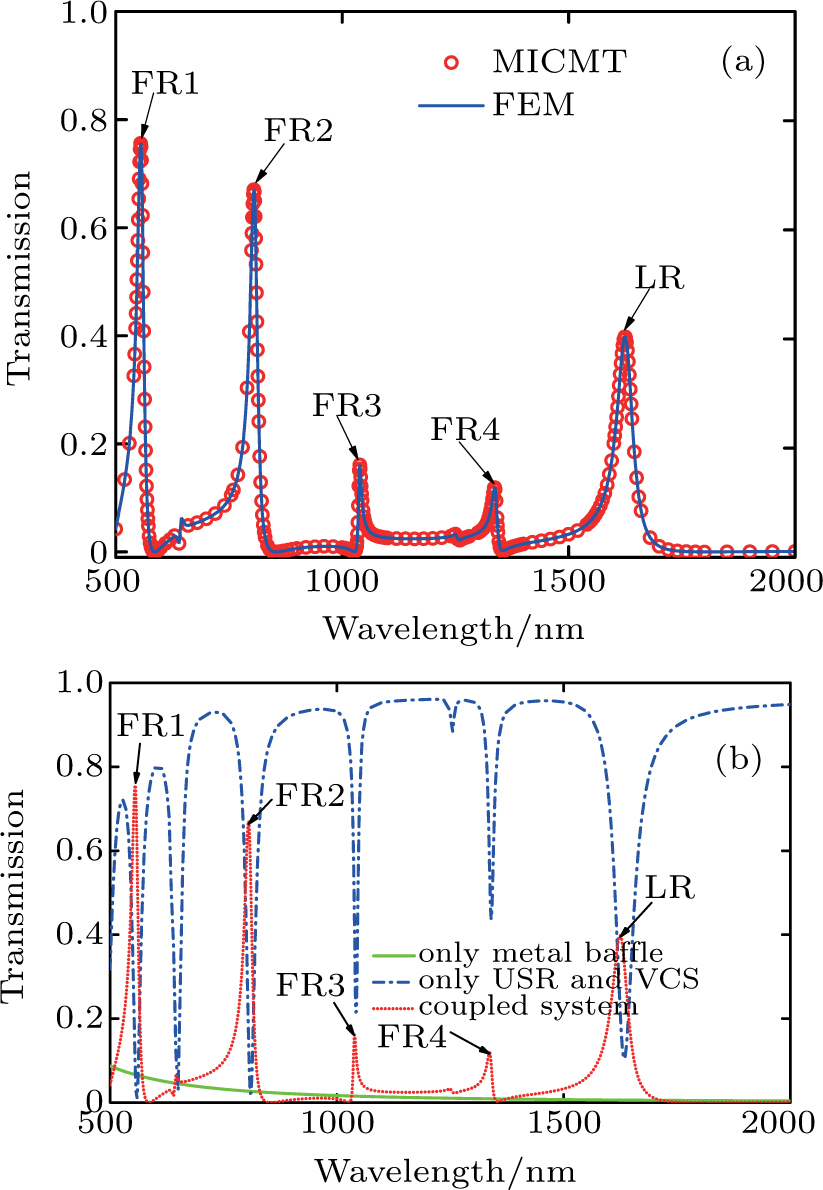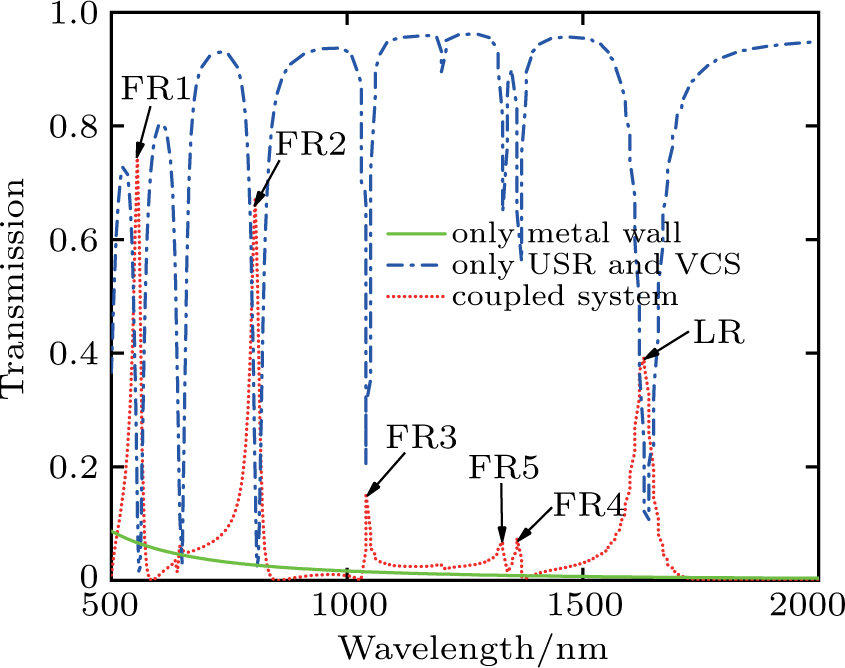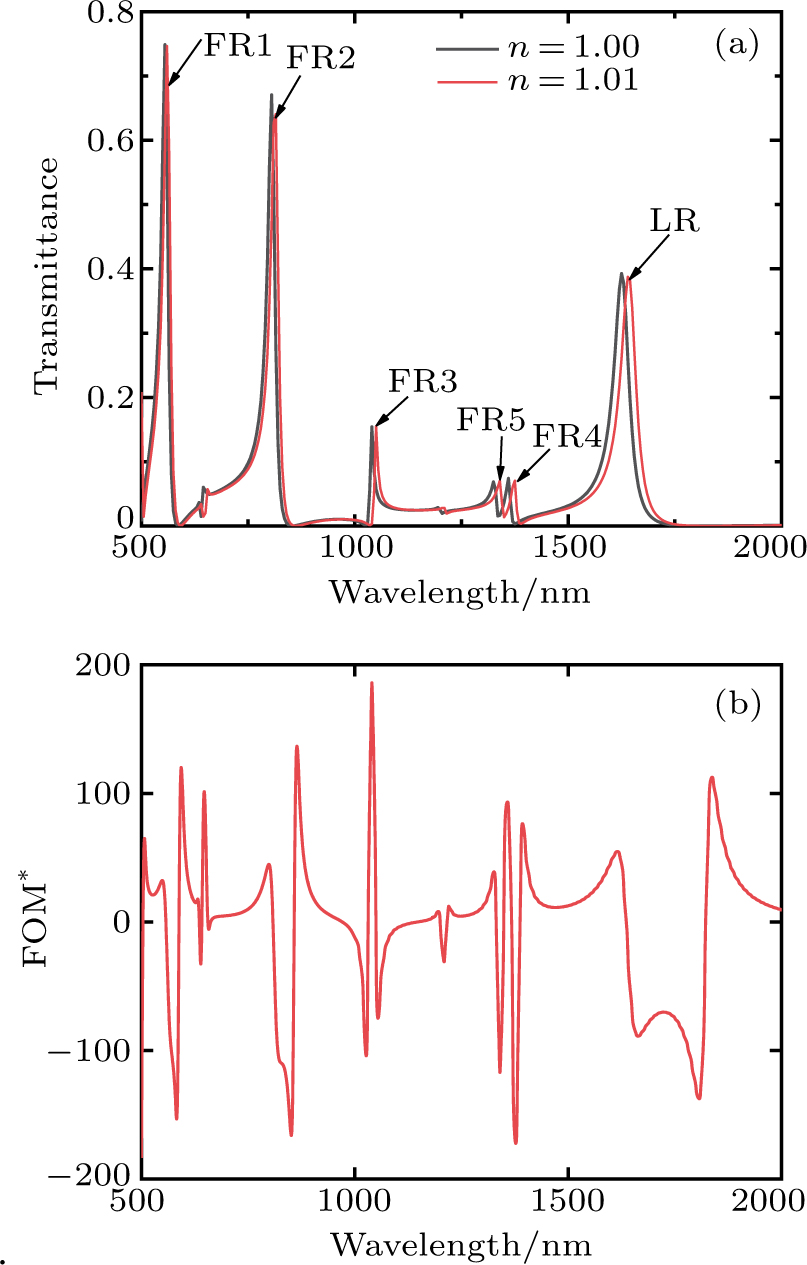† Corresponding author. E-mail:
Project supported by the National Natural Science Foundation of China (Grant Nos. 61367005 and 61865008) and the Natural Science Foundation of Gansu Province, China (Grant No. 17JR5RA078).
A single baffle metal–insulator–metal (MIM) waveguide coupled with a semi-circular cavity and a cross-shaped cavity is proposed based on the multiple Fano resonance characteristics of surface plasmon polaritons (SPPs) subwavelength structure. The isolated state formed by two resonators interferes with the wider continuous state mode formed by the metal baffle, forming Fano resonance that can independently be tuned into five different modes. The formation mechanism of Fano resonance is analyzed based on the multimode interference coupled mode theory (MICMT). The finite element method (FEM) and MICMT are used to simulate the transmission spectra of this structure and analyze the influence of structural parameters on the refractive index sensing characteristics. And the transmission responses calculated by the FEM simulation are consistent with the MICMT theoretical results very well. The results show that the figure of merit (FOM) can reach 193 and the ultra-high sensitivity is 1600 nm/RIU after the structure parameters have been optimized, and can provide theoretical basis for designing the high sensitive refractive index sensors based on SPPs waveguide for high-density photonic integration with excellent performance in the near future.
Surface plasmon polaritons (SPPs) are a kind of collective oscillation caused by the interaction between electromagnetic wave and free electrons on the metal surface. The SPPs can overcome the diffraction limit and confine light in subwavelength dimension, so it very promises to be used as an information carrier for high-density photonic integration circuits. The metal–insulator–metal (MIM) waveguide has strong binding ability to serve as SPPs with low transmission loss and bending loss, small structure size, long transmission distance, and many other characteristics, and it can realize the manipulation of nanoscale light. Therefore, the MIM waveguide is one of the most promising waveguide structures for realizing nano optical equipment and highly integrated nano optical circuits. Recently, Fano resonance has received attention of many researchers and has been realized in many systems. Moreover, the Fano resonance effect generated in the MIM waveguide structure is particularly sensitive to environmental change. Meanwhile, the Fano resonance, a sharp asymmetric line-shape, can be induced by changing the MIM waveguide structure, through which the higher quality factors and sensitivity than traditional Lorentz resonance can be achieved. The Fano resonance was found first in the autoionized state of atoms, and then in classical optical systems.[1] Ugo Fano pointed out that the interference between a wide continuum state and a narrow discrete state can give rise to asymmetric peaks in transmission spectra. Fano gave this phenomenon an earlier qualitative explanation.[1] This theory can also be extended to the interaction of one discrete level with two or more continua. Klimov et al.[2] verified the existence of Fano resonance by studying the optical characteristics of photonic crystals covered by perforated metal membrane, and proposed a method of designing a Fano resonance sensor sensitive to change in environmental refractive index. Klimov et al.’s experimental description of photonic crystals covered with perforated metal films provided a foreshadow for the research in this paper. Various MIM waveguide structures based on Fano resonance have been designed and manufactured, including optical multiplexer,[3,4] filter,[5] optical switch,[6] distributed Bragg reflector mirror,[7–9] which have the huge application prospect in biosensing technique, nano lithography,[10] and other fields. At the same time, other laboratory also conducted some researches of the applications of MIM waveguide absorbers,[11] perfect metamaterial absorber,[12–15] surface-enhanced Raman pectroscopy[16] and graphene plasmon-enhanced infrared spectroscopy.[17]
With the development of nanotechnology, on-chip high-sensitivity detection technology will become an important research direction for future sensors.[18] In Ref. [19], it was pointed out that the symmetry breaking introduced by an adjacent infinite dielectric can cause the plasmon modes of a metallic nanostructure to couple and hybridize. This effect is particularly large for entities with a large contact area adjacent to the dielectric. We can make transverse magnetic (TM) wave enter into the MIM waveguide structure, the SPPs will be generated at the MIM interface, the SPPs are a kind of collective oscillation caused by the interaction between electromagnetic waves and free electrons on the metal surface. In this way we can avoid adjacent entities with large contact areas of the dielectric. Due to the unique properties of Fano resonance and SPPs, the design of highly sensitive on-chip SPPs sensor that can be easily integrated with the help of these optical phenomena has become a research hotspot.[20] Wen et al.[21] proposed an MIM waveguide structure composed of a single baffle and a rectangular cavity, and studied the dual Fano resonance characteristics of the structure. The research showed that the multi Fano resonance system possesses important applications in nonlinear, slow-light, and bio-nanometer sensing devices. Wu et al.[22] proposed an MIM straight waveguide structure with branch nodes, studied and analyzed the effects of coupling spacing, geometric dimensions, and other parameters on Fano resonance peak. The results showed that the Fano resonance generated by this structure can be used to fabricate high precision sensors. Wu et al.[23] designed a kind of MIM waveguide-coupled circular ring and disc cavity structure, through continuously adding a section, which can be tuned to achieve independence in multiple Fano resonance. By changing the length of the section, the degree to which the multiple Fano resonance peaks varies is different from the single Fano peak does, because of the parallel processing ability of the multiple Fano resonance compared with that of the single Fano resonance. This structure had unique advantages in spectrometer and enhanced biochemical sensing.[24,25] The existing research on cavity mainly focused on the rule of the rectangular cavity or ring cavity, in addition, in the above studies, the position of the resonance peak needs adjusting by changing a certain parameter of the resonant cavity structure and the proposed structure was difficult to adapt to the existing level of manufacturing technology. So we design a structure which can realize the coarse modulation of the resonance peak position, the resonance peak can be independently adjust and easy to manufacture. Therefore, it will be widely used in the field of nano-refractive index sensing.[26]
In this paper, an MIM waveguide with a single metal baffle coupled with a semi-annular cavity and a cross-shaped cavity is designed. It is different from a square-shaped cavity which is easy to manufacture and study.[27] It can obtain more resonance peaks (finally, we obtain six resonance peaks). When the TM wave is incident into the MIM waveguide structure, the SPPs will be generated at the MIM interface, continuous states will be formed through the direct waveguide into the semi-annular cavity, and discrete states will be formed in the crosswise cavity. These continuous state and the discrete state are coupled to each other to form Fano resonance under the action of near field, forming five Fano resonances and one Lorentz peak. The transmission characteristics of Fano resonance formed by the coupling of the continuous state and the discrete state are analyzed by combining the multimode interference coupled mode theory (MICMT). The COMSOL software based on the finite element method (FEM) is used to simulate the structure, quantitatively analyze the influence of structural parameters on the sensing characteristics, refractive index sensitivity and FOM value, and then optimize the structural parameters, to realize the regulation of structural sensing characteristics and finally realize the multi-function and high-sensitivity sensor.[28,29]
In order to discuss the structure of a single baffle MIM waveguide coupled with a semi-circular cavity and a cross-shaped cavity, we start with a single exit waveguide resonant cavity system. The resonance mode can be fully described by only the equation which is satisfied by the mode amplitude of the isolated lossless resonator system obtained as follows:[30]








As shown in Fig. 

Schematic diagram of umbrella resonator coupled with MIM waveguide with metal baffle.


Here, the transverse propagation constant in air and Ag can be expressed by the following equation:







In the simulation of this paper, the geometric parameters of the structure are set to be as follows: waveguide width w = 50 nm, baffle width t = 30 nm, coupling distance g = 10 nm, vertical chamber length H = 450 nm, horizontal chamber length L = 450 nm, waveguide width of VCS D = 50 nm, outer circle radius Ro=370 nm, and inner circle radius Ri=320 nm. Throughout the paper, the normalized transmittance of waveguide structures is defined as the quotient of the power flow between output port s2 and input port s1 (acquired by integrating the Poynting vector over the MIM waveguide cross section). In addition, the transmission responses of the structure is calculated by the MICMT method and FEM simulation as shown in Fig.
To better understand the physical significance of Fano resonance, figure 

In order to make the whole system practical, considering the existing level of manufacturing technology, we analyze the effect of coupling distance g and width t of metal baffle on the performance of the whole system. First, we search the effect of the change in the lateral coupling distance g on the transmission spectrum of the whole system. As shown in Fig.
 | Fig. 4. Transmission spectra of MIM structure changing (a) with coupling distance g using FEM simulation, (b) with thickness of metal baffle t obtained from FEM simulation. |
We simulate the effect of the length of vertical resonator on transmission spectrum. As can be seen from Fig.
Then, we change the length of the horizontal resonator L from 400 nm to 500 nm in steps of 25 nm, and the change of the transmission spectrum is shown in Fig.
Because the wavelength value of the resonance peak and that of the dip of the same Fano resonance are very close to each other, our system is very excellent to make sensors. The influence of refractive index variation on transmission spectrum of the system is studied below. When we change the refractive index of the filling medium in the resonant cavity from 1.00 to 1.08 with the step 0.04, the change of the transmission spectrum is shown in Fig. 


In order to realize a chip-level integrated photonic device, multiple functions need to be performed simultaneously in a single SPPs’ structure. In this case, we use the symmetry breaking method to split the horizontal resonator L of the “umbrella’ refractive index sensor into L1 and L2, the other geometric parameters remain the same as previous ones. The umbrella resonator coupled with a metal baffle MIM waveguide symmetry-breaking structure is shown in the following Fig.
 | Fig. 8. Schematic diagram of umbrella resonator coupled with MIM waveguide with metal baffle (symmetry breaking). |
The transmission spectra of only metal baffle, only USR, VCS, and the whole coupled system are shown in Fig.
 | Fig. 10. Plots of transmittance versus wavelength of proposed system (a) before and (b) after symmetry breaking of horizontal resonant cavity for five different values of ΔL. |
Figure 
 | Fig. 11. Magnetic field distributions at wavelengths (a) 555.5 nm, (b) 805 nm, (c) 1039 nm, (d) 1327 nm, (e) 1360.5 nm, (f) 1626 nm, respectively. |
We verify whether the two Fano resonances can be regulated independently by adjusting the length and the length of the horizontal resonator as shown in Figs.
Then we fix L1 length at 205 to increase the length of the longer part of the horizontal resonator from 245 nm to 260 nm. From Figs.
The Fano resonance generated by the modified derived structure also has a very small resonance peak difference, so our system is very suitable for making sensors. We change the refractive index of the filling medium in the resonant cavity (n = 1.00 and n = 1.01), and the change of the transmission spectrum is shown in Fig.
In this paper, a single metal baffle MIM waveguide coupled with a semi-circular cavity and a cross-shaped cavity is proposed. When the TM wave is incident into the waveguide structure, the SPPs will be generated at the interface of the MIM. The SPPs form a continuous state on the metal baffle. Meanwhile, the optical signal enters into a semi-circular cavity and a cross-shaped cavity, forming a narrow discrete state. In the near field, the continuous state and the discrete state are coupled to each other to form Fano resonance. It is unable to manufacture the nanoscale materials in our laboratory, and there is no microwave chamber for measuring transmission spectra. So we use the FEM and MICMT to simulate the transmission spectra of this structure and analyze the influence of structural parameters on the refractive index sensing characteristics. There is in good agreement between the two results. Our structure not only is very sensitive to the change of refractive index, but also can realize the independent tuning of Fano resonance peak by changing the structure parameters of semi-circular cavity and cruciform cavity as well as the filling medium. Changing the structural parameters of L1, L2, H, g, and t can realize the Fano resonance peak position, the transmission rate, and bandwidth of the effective control, and can also have high sensing performance in the larger regulation range. And the study of the symmetry-breaking features shows that the structure can also produce obvious Fano resonance, and its mechanism makes the arrangement of Fano resonance structure more flexible. After optimizing the structure parameters, the maximum refractive index sensitivity of the device reaches 1600 nm/RIU and the FOM increases up to 193.00. The research results are of significance for guiding us in designing more simple, efficient, and easily machined on-chip highly sensitive micro-nano sensors.
| [1] | |
| [2] | |
| [3] | |
| [4] | |
| [5] | |
| [6] | |
| [7] | |
| [8] | |
| [9] | |
| [10] | |
| [11] | |
| [12] | |
| [13] | |
| [14] | |
| [15] | |
| [16] | |
| [17] | |
| [18] | |
| [19] | |
| [20] | |
| [21] | |
| [22] | |
| [23] | |
| [24] | |
| [25] | |
| [26] | |
| [27] | |
| [28] | |
| [29] | |
| [30] | |
| [31] | |
| [32] | |
| [33] | |
| [34] | |
| [35] | |
| [36] | |
| [37] | |
| [38] | |
| [39] | |
| [40] | |
| [41] | |
| [42] | |
| [43] | |
| [44] | |
| [45] | |
| [46] | |
| [47] | |
| [48] | |
| [49] | |
| [50] | |
| [51] | |
| [52] |










